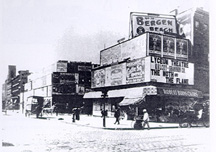 |
42nd
Street is the only major
New York City street to have been developed almost entirely in the 20th
century. In 1889, Oscar Hammerstein built his Victoria Theater on the
northwest corner of 42nd Street and 7th Avenue in a stable residential
neighborhood, complete with brownstones, churches and public buildings.
Six years later, the city's first subway line opened at Times Square and
within fifteen years, both sides of 42nd Street between 7th and 8th Avenues
had become home to the world's greatest concentration of theaters, as well
as to a host of other commercial establishments serving the crowds drawn
by the shows. 42nd Street in 1896 |
| 42nd
Street has
always stayed true to its primary purspose as a good-time place. Even after
Prohibition in 1919 staunched the flow of champagne in 42nd Street's glam
restaurants, popular-priced eateries quickly took their place. 42nd Street
took on a more democratic and middle-class aspect. Hubert's Museum, better
known as the Flea Circus featured performing fleas and a shooting gallery.
During the Depression, 42nd Street became a movie center. By 1934, only
the New Amsterdam continued as a "legitimate" theater. Times
Square in 1937 |
 |
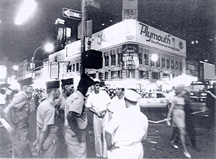 |
42nd
Street continued on as a
premier showcase for the movie industry until the 1960s flight to the suburbs
and other changes turned the street into a premier pornography district.
But even as property values plunged, Times Square remained one of the many
paradigms of New York City life. You couldn't get tougher, seedier or more
New York than 42nd Street. Times Square in
1970. |
| 42nd
Street was overdue for
a facelift and in the 1980s, New York City and New York State joined together
to renovate Times Square. The original plan consisted of four office towers
for the Prudential Insurance Company. However, the real estate market crashed
and a less expensive interim plan was put into action that would focus
on renovating the old theaters and all that went with them: restaurants,
stores and tourist establishments. Creative Time's 42nd Street Art Project
marked the beginning of this renovation process. Artists took to the empty
Times Square theaters and shops and gave them temporary lives and identities
while they awaited permanent reconstruction. Times
Square in 1993. |
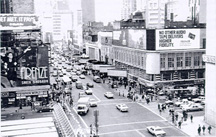 |
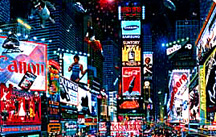 |
42nd
Street today is a dizzying
jungle of lights and signs all fighting to be louder, brighter and bigger.
It's a strange and eclectic combination of Coney Island and Manhattan glam
with Mom and Pop stores that look just a little too glitzy to be real.
Disney has taken over the New Amsterdam Theater and the Victory Theater
no longer features live nude ladies, but children's plays instead. Times
Square is still changing everyday and while it has already become the tourist
and family mega-center its creators hoped it would be, the final result
should be strange and unexpected nonetheless. Times
Square Today |
 |
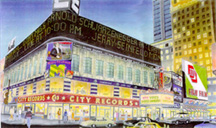 |
![]()
![]()